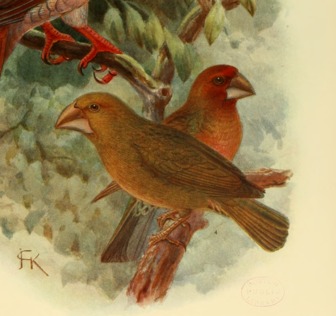Bonin Grosbeak
The Bonin Grosbeak or Bonin Islands Grosbeak is an extinct finch, the only species of the genus Chaunoproctus. It is one of the diverse bird taxa that are vernacularly called grosbeaks, but it is not closely related to the grosbeaks sensu stricto. It was a retiring, although not shy bird, and was usually found singly or in pairs. It fed on fruits and buds which were primarily picked up from the ground or low shrubs; it rarely was observed to perch in trees, being apparently rather phlegmatic and somewhat reluctant to fly. Only one kind of vocalization has been described: a soft, pure and high note, sometimes short, sometimes drawn out; sometimes given singly, sometimes in a short series.

The Bonin Grosbeak is classified as Extinct (EX), there is no reasonable doubt that the last individual has died.
The Bonin Grosbeak or Bonin Islands Grosbeak (Chaunoproctus ferreorostris) is an extinct finch, the only species of the genus Chaunoproctus. It is one of the diverse bird taxa that are vernacularly called "grosbeaks", but it is not closely related to the grosbeaks sensu stricto. It was a retiring, although not shy bird, and was usually found singly or in pairs. More
The Bonin Grosbeak was discovered by the Beechey Pacific expedition, which collected 2 specimens on Chichi-jima in 1827. The following year, Kittlitz took several more specimens, but he only gave the locality "Boninsima" (="Bonin-shima": Ogasawara Islands). Following the report of two shipwrecked sailors, picked up by Beechey, that the island would make a good stopover station for whalers, settlement was begun in 1830. More
Bonin Grosbeak Chaunoproctus ferreorostris (Vigors, 1829) * RMNH 90732: male. Bonin Islands. Collector: Kittlitz. Syntype of Fringilla Papa Kittlitz, 1831. * RMNH 90733: female. Bonin Islands. Collector: Kittlitz. Syntype of Fringilla Papa Kittlitz, 1831. Fatal newcomers The German naturalist Friedrich von Kittlitz visited many Pacific islands. Several of the insular forms he collected later became extinct. More
Bonin Grosbeak Chaunoproctus ferreorostris 2009 IUCN Red List Category (as evaluated by BirdLife International - the official Red List Authority for birds for IUCN): Extinct Family/Sub-family Fringillidae Species name author (Vigors, 1828) Taxonomic source(s) Brooks (2000), Sibley and Monroe (1990, 1993) Summary Chaunoproctus ferreorostris is only known from specimens collected in 1827 and 1828 on Chichi-jima, Ogasawara-shoto (Peel Island, Bonin), Japan1. More
Bonin Grosbeak Chaunoproctus ferreorostris (a finch), found only on the Ogasawara Islands, which was last recorded in c. 1832, and the Kona Grosbeak or Grosbeak Finch, a Hawaiian honeycreeper, last recorded in c. More
Bonin Grosbeak Chaunoproctus ferreorostris (a finch), found only on the Ogasawara Islands, which was last recorded in c. 1832, and the Kona Grosbeak or Grosbeak Finch, a Hawaiian honeycreeper, last recorded in c. 1896. Finally, the weaver family (Ploceidae) contains a species called the Grosbeak Weaver. Copyright: Wikipedia. This article is licensed under the GNU Free Documentation License. It uses material from Wikipedia. More
Bonin Grosbeak Chaunoproctus ferreorostris Bonin Grosbeak Photographer : More
Bonin Grosbeak - Chaunoproctus ferreorostris = IUCN Status: Extinct IUCN Species Profile Bonin Information Service - Bonin Grosbeak (Pic.): Bonin Grosbeak (extinct). http://www.bonin-islands.com/what/ Bonin Information Service - About the Bonin (Ogasawara) Islands: Changes to the environment have caused the extinction of some species, such as the Bonin grosbeak chaunoproctus ferreorostris, or drastically reduced the ... http://www.redlist.org/search/details. More
Bonin Grosbeak a finch, and Bonin Thrush. The island was the only known home of the thrush and probably the finch, although the heron was found on Nakōdo-jima (also "Nakoudo-" or, erroneously, "Nakondo-") as well. The existence of the birds was documented by von Kittlitz in 1828, and five stuffed thrushes are in European museums. The Bonin Wood-pigeon died out in the late Nineteenth century, apparently as the result of deforestation or the introduction of alien mammals or from both causes. More
the Bonin Grosbeak Chaunoproctus ferreorostris and Bonin Trush Zoothera terrestris. Most of our knowledge of the birds of the Bonin Islands comes from the crew of HMS Blossom, who collected various species new to science. A second important source of information was the German ornithologist Friedrich von Kittlitz, who visited the island in 1828. That year he discovered a ground thrush which had been overlooked by the English. More
Just like the Bonin Grosbeak, the Bonin Thrush probably succumbed soon after 1830 to predation by the introduced mammals and habitat destruction. - ABOUT ME More
Results for: bonin grosbeakTranslations 1 - 30 of 37 English English Finnish Finnish bonin grosbeak bonininnokkavarpunen, Chaunoproctus ferreorostris bonin woodpigeon bonininkyyhky, Columba versicolor bonin thrush peelinrastas, Zoothera terrestris bonin honeyeater bonininmesikko, Apalopteron familiare bonin islands petrel kurosivonviistäjä, Pterodroma hypoleuca evening grosbeak amerikannokkavarpunen, Hesperiphona vespertina são tomé grosbeak More
Family : Fringillidae
Genus : Chaunoproctus
Species : ferreorostris
Authority : (Vigors, 1828)
